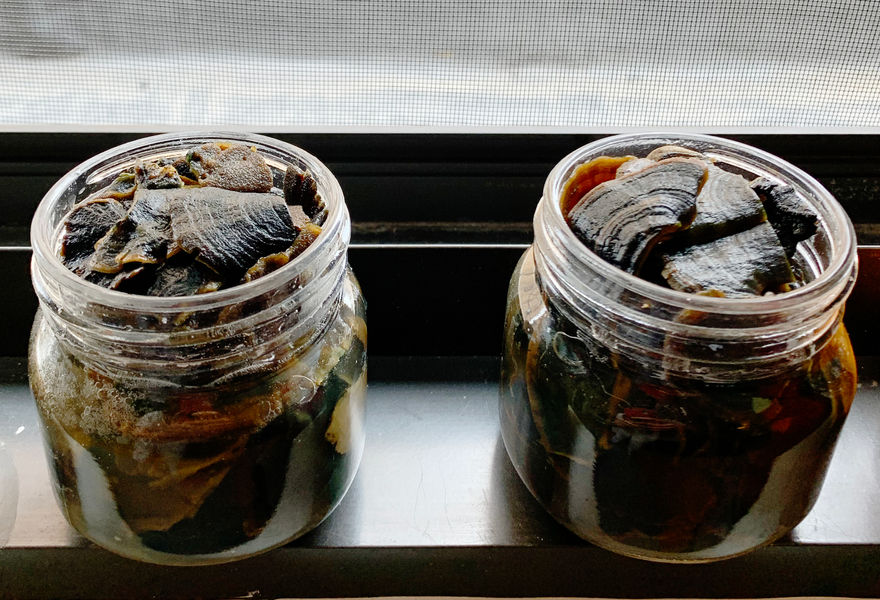HEAJOO (YVONNE) LEE
Biodegradable
Textile & Material
Team Project for Biodesign Challenge (BDC) in 2020
Heajoo Lee // Sandra Olave // Erica Schumacker
Many approaches explore natural dyeing but fail to address the current environmental degradation. We are proposing an industrial dyeing method that replaces synthetic dyeing while simultaneously remediating polluted environments in and around industrial dyeing sites.
Welcome to the mushroom dyeing revolution.
TEXTILE DYE INDUSTRY
Despite prohibition of approximately 4000 dyes with known toxicity, mutagenicity, and carcinogenicity, over 100 are still used in the market (Lellis, Bruno, et al., 2019). Their effects on human and environmental health is wide reaching. Wastewater discharge from dye and textile industries pollutes waterways that serve as a source of drinking water, such as in India, Bangladesh, and China. These pollutants prevent sunlight from reaching photosynthetic organisms which can disrupt the global food chain and cause lasting negative impacts ( Hassanet al., 2018).


FUNGI
Fungal microbes play an essential role in the development of earth’s atmosphere providing a symbiotic link for plants to obtain nutrients from the soil, which helped create a habitable environment. Fungi have the unique ability to breakdown matter, essential for planet earth health and maintenance. Fungi have been cleaning up the earth for more than 400 million years, and their role is just as important today as it was back then. Fungi could be the missing link to transitioning away from the use of synthetic dyes in the textile industry and toward the use of natural pigments. These incredible organisms can potentially clean up the existing textile pollution while also providing a natural replacement for toxic dyes.
MYCOREMEDIATION
Fungi, and particularly wood decay fungi, stand out as a promising natural dye alternative because in addition to providing a source of particularly color fast pigment, they can also be used to bioremediate existing dye pollution. It is this ability to replace AND remediate that makes this project not just about the closure and replacement of synthetic dye factories, but the conversion of factories to natural dyeing and centers of mycoremediation. The main function of fungi in the ecosystem is decomposition, which is performed by fungal mycelium. These natural compounds are composed of long chain molecules of carbon and hydrogen atoms which share a similar structure to many organic pollutants, allowing the fungal enzymes to degrade them.

Experimental Process



HARVEST
FERMENTING
DYE
By utilizing local fungal varieties, fungal dyes produced in certain cities or countries brand their local mycology into an identifying color. For instance, Jack-O-Lantern or Omphalotus olearius, found only in California produces a fluorescent orange fruiting body. The unique derivative dye identifies the provenance of the resulting fabric, making it unique, precious, and local.
This new model for dyeing subverts the placelessness of global textiles and replaces it with one in which color indicates identity and sustainability for both the consumer and the producer. There are three primary types of natural dye extraction from Fungi which all involve the lancing of cell walls in order to increase surface area for chromophore containing organic compounds to be released from the mushroom material into the dye solution.
STEP I: HARVEST
Mycelium Link conducted experiments with Turkey Tails, trametes versicolor, to obtain dyes. We grew mushrooms at home, purchased dried mushrooms online, as well as foraged locally at a nearby park in Detroit.
 |  |  |
|---|---|---|
 |
STEP II: FERMENTING
Harvested mushrooms dyes are extracted by fermenting mushrooms in a glass container with ammonia and water. A higher ammonia ratio will enhance dye color extraction. Additionally, the longer it ferments, you can obtain a deeper color.
 |  |  |
|---|---|---|
 |
STEP III: DYE
This project evaluated three types of dye extraction, boiling (dye bath), ammonia extraction, and saline fermentation; however, there are many more complicated scientific methods available.


METHOD I:
BOILING (DYE BATH)
Boil mushroom color extraction requires a 1:1 ratio dried mushroom to one ounce of wool. Break up the dried mushrooms into pieces and soak into distilled room temperature water for at least an hour. To boil the mushroom, use enough water allowing mushroom pieces to float freely. Bring to 170–180°F and “cook” for one hour.

METHOD II:
AMMONIA EXTRACTION
This method involves placing the mushrooms into a jar with a 1:1 ratio of household Ammonia and water, and allowing the pigment to be extracted chemically. The longer the mushrooms and ammonia sit, the deeper the color that should develop.

METHOD III:
SALINE FERMENTATION
Saline fermentation is similar to the Method II process. Mushrooms are submerged into a 2.5% saline solution in a glass container allowing the pigment to develop as a result of fermentation.
Mushroom Dye Colorway
Mushroom dyed fabric with pH variance
In fungal species, the most common natural dye compounds are Terphenol Quinones, which are enhanced with alkalinity and yield blue, purple, and green hues, and Anthraquinones, which are enhanced with acidity and yield red, orange, and yellow hues. Both silk and wool, protein fibers materials yielded different tones of tan and brown; however, a few unconventional methods lead to surprising results. By experimenting with multiple extraction methods, the pH, and dye bath contents, numerous colors were successfully obtained.

Final Fabric Pieces
Mycelium Link appears to have superior color fastness and vibrancy to other natural methods. One core species, wood decay fungi, may allow us to produce vibrant, locally unique, color fast dyes, while simultaneously remediating the toxic impact of years of dye pollution. Between the transition to natural dyes in the future, and the remediation of the toxic manufacturing practices of the past, fungi dyeing may just be the mycelium link.








